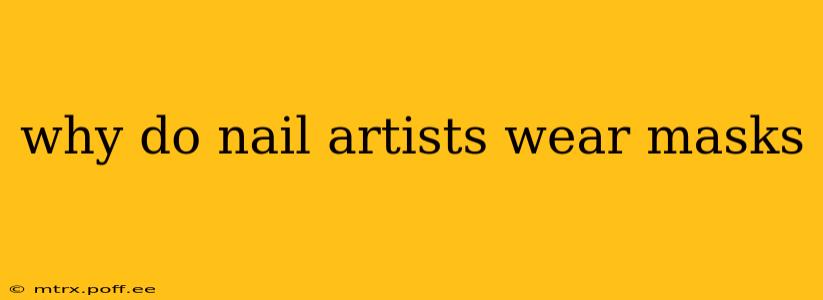Nail technicians often work in close proximity to their clients, using various chemicals and creating dust. This necessitates the use of masks for both the safety of the artist and the client. Let's delve deeper into the reasons behind this crucial practice.
What are the potential health hazards for nail artists?
Nail salons utilize numerous products, many containing potentially harmful chemicals. These include:
-
Acrylates: Used in acrylic nail applications, acrylates can cause respiratory irritation, skin allergies, and even asthma in some individuals. The dust created during filing and shaping of acrylic nails further exacerbates this risk.
-
Solvents: Acetone, used for nail polish removal, and other solvents are volatile organic compounds (VOCs) that can irritate the eyes, nose, and throat. Prolonged exposure can contribute to headaches and other health issues.
-
Nail Polish: While some polishes are formulated with fewer harmful chemicals, many still contain VOCs and other ingredients that can cause irritation or allergic reactions. The fumes released during application can be problematic.
-
Dust: Filing and buffing nails generates fine dust particles containing acrylic, polish residue, and other materials. Inhaling these particles can cause respiratory problems.
What are the potential health hazards for clients?
While not directly exposed to the same concentration of chemicals as the nail technician, clients still face risks. Inhaling the fumes from nail products can contribute to respiratory issues, especially for individuals with pre-existing conditions. Furthermore, poorly sanitized tools can transmit infections.
What types of masks do nail artists use?
The type of mask worn varies, but generally, these are preferred:
-
N95 Respirators: These offer the highest level of protection against airborne particles, including fine dust created during filing and shaping. While not always necessary, they are recommended when working with acrylics or other dust-producing materials.
-
Dust Masks: These provide protection against larger dust particles but are less effective against fine particles and fumes.
-
Surgical Masks: These offer minimal protection against airborne particles and fumes but are better than nothing and provide a barrier against droplets.
Are there other safety precautions nail artists should take?
Beyond masks, other important safety precautions include:
-
Good Ventilation: Well-ventilated salons significantly reduce the concentration of airborne chemicals.
-
Proper Glove Use: Gloves protect the hands from chemicals and prevent the spread of germs.
-
Regular Cleaning and Disinfection: Thoroughly cleaning and disinfecting all tools and surfaces prevents the transmission of infections.
-
Proper Waste Disposal: Disposing of hazardous waste correctly is crucial for environmental protection and the health of both technicians and clients.
What are the long-term health effects of not wearing a mask?
Long-term exposure to the chemicals and dust in nail salons without proper protection can lead to various health problems, including:
-
Chronic Respiratory Issues: Asthma, bronchitis, and other respiratory illnesses are more likely to develop with prolonged exposure.
-
Skin Allergies and Irritations: Contact dermatitis and other skin conditions are common among nail technicians who don't take proper precautions.
-
Neurological Effects: Some chemicals used in nail products may have neurological effects with prolonged exposure.
In conclusion, nail artists wear masks to protect themselves and their clients from the potential health hazards associated with the chemicals and dust produced during nail treatments. This is a critical safety measure that should never be overlooked. The use of appropriate masks, coupled with other safety precautions, creates a much healthier and safer working environment for everyone involved.
